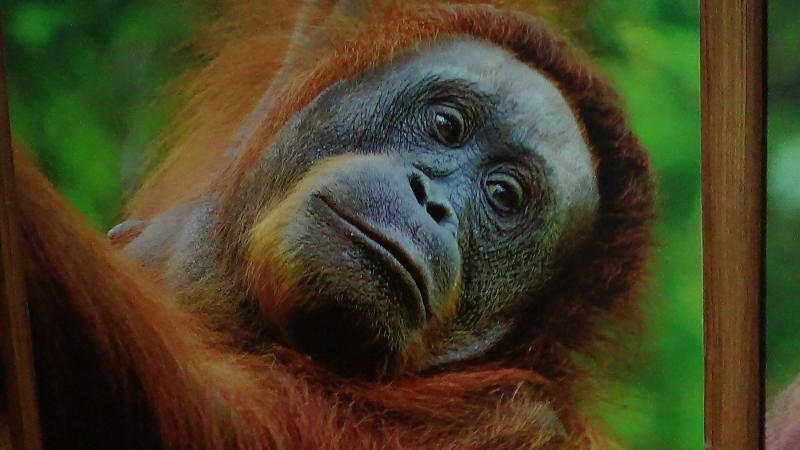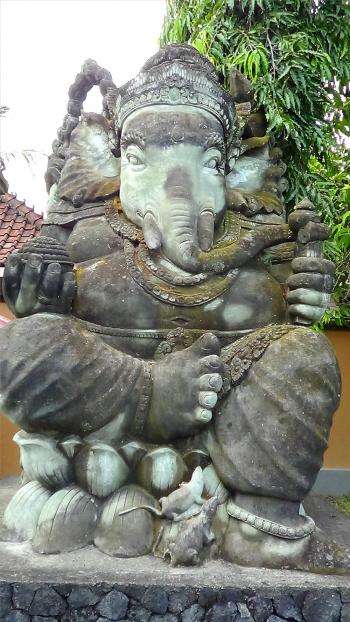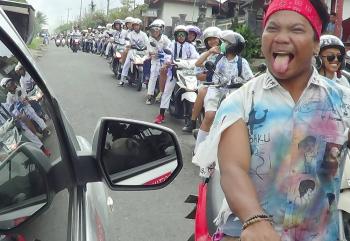Enjoying world-class accommodations and wonderful wildlife on a tour of Malaysia, Indonesia and Singapore
This article appears on page 42 of the December 2016 issue.
The third-largest island in the world, Borneo is bisected by the equator, claims more than 600 bird species and is home to nearly all of the world’s population of orangutans. It belongs to Malaysia, Indonesia and Brunei, each country governing its own section.
Visiting Borneo demanded a custom tour, and my wife, Marcia, discovered Audley Travel (Boston, MA; 855/838-8300, www.audley travel.com) and their Southeast Asia Senior Specialist, Jack Tydeman. He proposed a private guided tour for 29 days, which we budgeted down to a hectic 19 days, covering all our interests and including stops in Malaysia, Indonesia and Singapore.
Audley Travel packaged all transfers, touring, accommodation and in-country flights. The company also compiled a custom binder with information on all of the countries in our itinerary, vividly elaborating all aspects of our journey. This helped us organize all the moving parts of our trip.
Useful advice — such as US dollar bills are largely useless, Internet access is available, and our Singapore hotel would provide smartphones with unlimited international calling for free — was provided as well.
We usually self-insure, but for this trip we purchased a WorldWide Trip Protector policy from USAA. We listed our journey with the US State Department’s Smart Traveler Enrollment Program (step.state.gov) and downloaded country information from the websites of the State Department, the CIA and the Australian government (smartraveller.gov.au).
We already had sufficient vaccinations from prior journeys, visas were not required, and no special security cautions were suggested. We decided not to use our malaria pills for the brief time we were there.
The itinerary
Our central objective was to meet and greet orangutans in the wild. The adventure was enhanced to include other parts of Malaysia as well as Indonesia and Singapore, with air stopovers in Doha, Qatar. In total, this 19-day, escorted private tour in May 2016 covered seven Southeast Asian countries or protectorates, 11 flights, 7 hotels, 12 time zones, 6 tour guides and 24,300 air miles.
We skirted the equator and experienced some super tropical days.
Our itinerary was somewhat hyperactive. We would begin by flying from Philadelphia to Kuala Lumpur, Malaysia, where we would spend two nights. Then we would take a flight to Kuching, in Malaysian Borneo, for a 3-night stay, followed by a flight north to Sabah state, also in Malaysian Borneo, for an overnight, then a 65-mile riverboat ride to spend two nights riverside in the jungle.
From there we would fly to Denpasar, Bali, Indonesia, and drive to Ubud for four nights at the Chedi Club Tanah Gajah. Then it was on to Yogyakarta, Java, for two nights before ending with a 2-night, 1-day stay in Singapore.
We flew coach class round trip on Qatar Airways for $1,105 each — about $100 per time zone. The total trip cost for the two of us, including all international and regional air, hotels and private touring, was $15,776, or about $420 per person per day, which seems quite reasonable for a private tour.
Qatar Airways’ equipment was the very latest Airbus A350-900, a 2-aisle wide-body seating about 300 passengers and configured with surprisingly comfortable coach seats. Their impressive flight staff came from all over the world.
The in-flight entertainment system was modern, but it had few closed-caption movies in English. Two unique options were the live image from a rudder-mounted camera, viewable during the flight, and recorded Quran lessons. The food was plentiful and varied and served hot.
On these long hauls, time is meaningless, and it was easy to movie-binge, fog out and pig out.
Malaysia Airlines, Indonesia AirAsia and Garuda Indonesia Airlines were used for in-country travel, and our flights departed on time and without drama, although airport security was not vigorous.
We were very alert regarding our privacy and security, and not one single security issue arose during our entire journey. Our biggest problems were one “attack” scorpion and keeping the scheming macaque monkeys from appropriating our food and valuables.
As our trip unfolded, we confirmed Audley Travel’s expertise, as the execution of our aggressive 19-day travel plan was superb, with not a single glitch or unwanted surprise. At every stop, a driver and guide in a private car delivered us to our hotel and provided private tours, except in Singapore, where we explored on our own.
Our local tour guides were exceptional, friendly and knowledgeable, and they clearly understood how to manage guests.
The hotels in the big cities were 4- or 5-star and worthy of the distinction. However, the jungle lodge in Borneo was explorer level and without air-conditioning.
Kicking off in KL
We arrived at Kuala Lumpur, the capital of Malaysia, at night and stayed at the deluxe Mandarin Oriental hotel. They provided a world-class breakfast, with selections from six cultures that took several minutes just to inventory.
Our guided 4-hour city walking tour included a subway ride and notable historic sites. We visited the so-called “money-lending street,” among other colorful streets and alleys, and were treated to Malaysia’s tranquil multicultural society. Our dance card was full every day.
On Day 4 we flew to Kuching, the capital of the state of Sarawak, and stayed at the 4-star, centrally located Ranee Boutique Suites.
After a picture-perfect boat ride on the South China Sea to Bako National Park, we toured the rainforest, visited the crocodiles and the devious macaque monkeys and attempted to climb very challenging steps made of tree roots. We saw bearded pigs and proboscis monkeys, but birds were scarce that day. The open-boat ride back was refreshing.
That evening we walked to the Topspot Food Court, where dozens of vendors prepared fresh fish dishes. It was overflowing with atmosphere, and $15 bought a meal for two with drinks.
In the jungle
Since the primary objective of our trip was to see orangutans in their natural setting, the next morning we visited the Semenggoh Wildlife Centre in Sarawak. About eight orangutans who live in the wild arrived early for their 9 a.m. feeding, to the delight of an appreciative crowd. The family was playfully swinging on vines and putting on quite a show.
Boss mama and her 4-year-old child had the pick of the food; all the other orangutans stayed at a distance until they were done.
That afternoon we took a refreshing river cruise to the Santubong mangroves in search of wildlife and learned about the symbiotic ecosystem of the mangrove swamps. Again, it seemed the birds were away on holiday.
On Day 7 we flew north to Sandakan in Malaysia’s Sabah state, where we stayed at the simple Sepilok Nature Resort for two nights.
We visited an upscale farmers’ market that offered no crafts, but the happy gene was evident everywhere!
In the morning, we anxiously traveled to the Sepilok Orangutan Rehabilitation Centre hoping for further encounters. The facility was impressive, as was their good work, and a crowd assembled for the 10:00 feeding. We waited and waited, but nobody showed up. We got stood up by the orangutans!
Everyone was disappointed at this lack of turnout, so we were grateful we had previously visited Semenggoh. As a consolation, we learned about the Borneo sun bear, the world’s smallest.
The day’s highlight turned out to be a 65-mile cruise on the Kinabatangan River to the Sukau Rainforest Lodge in a covered speedboat with dual 150-horsepower Yamaha outboards. For 2½ hours we were mesmerized by the meandering jungle river, expansive vistas and wildlife galore, including a family of shy pygmy elephants that were swimming while their youngsters played in the water.
The boat ride ended at the Sukau Rainforest Lodge. It was hot, even for the season, and the jungle lodge lacked air-conditioning and hair dryers. We survived thanks to the somewhat cooler nights, fans and endless bottles of water (not to mention the good food at our candlelight dinner).
At Sukau, our wildlife-spotting boat explorations of different areas of the river were scheduled in the foggy dawn and late afternoon. An evening rainforest walk and lecture rounded out our jungle experience.
It was so humid that my Sony videocamera died due to heat prostration. Although it always feels like summer near the equator, the locals blamed the excessive heat on El Niño.
Living in luxury
On Day 10 we returned to Sandakan by speedboat, again meandering for 65 miles on the river and seeing little evidence of civilization. After two airplane rides over water, we arrived at Denpasar, on the island of Bali, in the evening. As usual, our guide and driver were waiting, ready to take us on a 90-minute drive to Ubud and the deluxe Chedi Club Tanah Gajah, where, after midnight, we quickly checked into villa No. 8 (of 20) and collapsed.
When we awoke on Day 11, we were astonished to find ourselves in an over-the-top 5-star property. Our villa had high surrounding walls that enclosed a private lap pool and a sunning area, and the interior was tastefully decorated with luxury furnishings.
The surrounding facility was like a fairyland, with lakes, fountains, walkways, a huge pool, a fine outdoor restaurant and an on-site art museum. A pineapple soup we had for dessert had us begging for seconds.
We also attended a colorful community dance performed by 60 local villagers.
Five stars might not be enough credit for the 105 employees who run this classy place. The owner, a noted architect, lived elsewhere, but his private art collection was on display everywhere.
In Bali, everything is a work of art. The furnishings and finishes were precise and harmoniously balanced. Surrounded by rice paddies, Chedi Club didn’t even have any annoying bugs!
After skinny-dipping in our private pool and sunbathing, it was time for breakfast, which didn’t disappoint.
At 9:30 a.m. our butler, Yuni, introduced herself. We were at a complete loss! This adorable, smart young lady anticipated our every need during our stay and spoiled us silly.
Exploring Bali
Each adjacent town we visited in Bali specialized in manufacturing specific products. There was a town for woodcarving, another for silver working, batik cloth, stone carving, etc. We had no trouble shopping at the super-high-quality village galleries. Their woodcarvings expressed the highest craftsmanship we have seen anywhere. The carved masks were terrific, and we could not resist acquiring a few pieces.
Next, we visited Ubud, a center for Balinese arts and crafts.
At the Ubud Palace we stumbled across a huge community preparation for an elaborate public funeral and cremation ceremony, for a member of royalty, the likes of which we had never seen. It involved a 5-story funereal tower and a huge, 5-story gilded sarcophagus in the shape of a golden bull. While it must have weighed tons, it was braced to be moved by dozens of men — no machines.
The deceased was carried in the funereal tower, on the shoulders of men, to the cremation grounds. The body was transferred to the golden bull, which was then incinerated to facilitate the journey of the deceased’s soul to the afterlife.
The funeral proceeded the next day, but we, disappointedly, had to opt out of attending the funeral due to the extreme heat and expected large crowds — a wise move, as we later heard that some tourists passed out.
On Day 12 we drove to Pura Ulun Danu Bratan, a Hindu lake temple complex from the 1600s that is located high up in central Bali and accessible only by narrow, winding roads.
It is situated on a picture-perfect mountain lake that fills an extinct volcanic crater. This UNESCO World Heritage Site is a favorite tourist attraction.
At that altitude, it was refreshingly cool, and we saw faces of travelers from all over the world. There, we paid our respects to Ganesha, our favorite deity in the Hindu pantheon.
The next day we toured and shopped in the silver town, the kite town, an art village and the stone carvers’ town, then took a private Paon Bali Cooking Class (paon-bali.com) in Ubud (IDR350,000, or $27, per person). We were taught how to commingle a sizable number of local ingredients into a regional delight. We cut, diced, mashed (with mortar and pestle) and cooked, then ate what we produced — but there was so much food, we also fed our driver and guide.
Java
On Day 14, sad to depart Bali, we flew to Yogyakarta, Java, where we stayed at the Phoenix Hotel for two nights. Indonesia is the world’s largest archipelago, comprising some 17,500 islands that straddle the equator for about 3,000 miles. Home to 260 million people, it is the fourth-most-populous country in the world.
Yogyakarta is an important travel destination due to the ancient and picturesque Borobudur and Prambanan temples, and we visited both of these UNESCO World Heritage Sites.
At 4:15 in the morning we headed out to tour Borobudur, where the blessing is the view of the sunrise from the top of the ancient temple.
Borobudur, built in the ninth century and then “lost” for 500 years, is one of the greatest Buddhist monuments in the world and, by far, Indonesia’s greatest visitor attraction.
After climbing numerous uneven steps, we were astounded at the number of people who had beaten us to the top before dawn.
To appreciate local village life, we toured the small farming village of Candirejo, traveling on a donkey cart guided by a young Muslim lady who had the most interesting stories to relate. Again, we noticed that the happiness gene prevailed there.
We were impressed with the tranquility of this society, made up of a mix of cultures cooperatively living together.
Later we visited the immense, ninth-century Prambanan Hindu temple complex, which features a massive central building surrounded by individual temples and shrines.
In the evening, we dined at a nearby outdoor restaurant, then attended a performance of the Ramayana ballet. This colorful 8-act classic ballet about a beautiful princess was set in a most picturesque locale, with ancient temples lit and looming in the background.
On to Singapore
On Day 16, our flight to Singapore was a real eye-opener as we flew over a vast “parking lot” of oil tankers and merchant ships idled by the economy.
Singapore is located at the southern end of the super-strategic Strait of Malacca, which links the Indian and Pacific oceans and is the most direct route between China and the Middle East.
We settled in at the deluxe, quayside Fullerton Hotel, a grand old lady converted from a British post office. The hotel is centrally located, with outstanding views and a rooftop infinity pool — a delight in the oppressive heat.
This independent city-state has to be the finest architectural feast we have seen anywhere in our travels. Whether designing a business or residence, the city’s architects have vigorously outpaced each other, resulting in a creative and stunning sketchbook of high-rise buildings.
Singapore is a bit quirky, but the streets are spotless, unemployment is low, the police are invisible, and crime is rare (with harsh penalties, like death, for drug trafficking and hefty fines for spitting in the street or importing or chewing gum!).
We took a morning highlights bus tour of the city, which included the Botanic Gardens, the National Orchid Garden and a number of historic sights. With so many interesting skyscrapers to see, my neck required a massage by the time we were done.
We also toured the creative National Gallery, a building within a building, and a few other museums located a stone’s throw from our hotel, just across a vintage iron suspension bridge.
Desperate to see birds, we visited the Jurong Bird Park, which was delightful. We attended the daily bird show there, featuring talking parrots and a flamboyance of flamingos.
After three days in Singapore we had barely scratched the surface, but it was time to depart for home. We should have left more time for Singapore.
Singapore’s Changi Airport was huge and modern, and the security was impressive.
Looking back on our journey, we were treated to an alternate travel universe where planes depart on time, luggage arrives intact, tour escorts drive Mercedes, and everything is wonderful. We even pushed past our life goal of visiting 100 countries!



